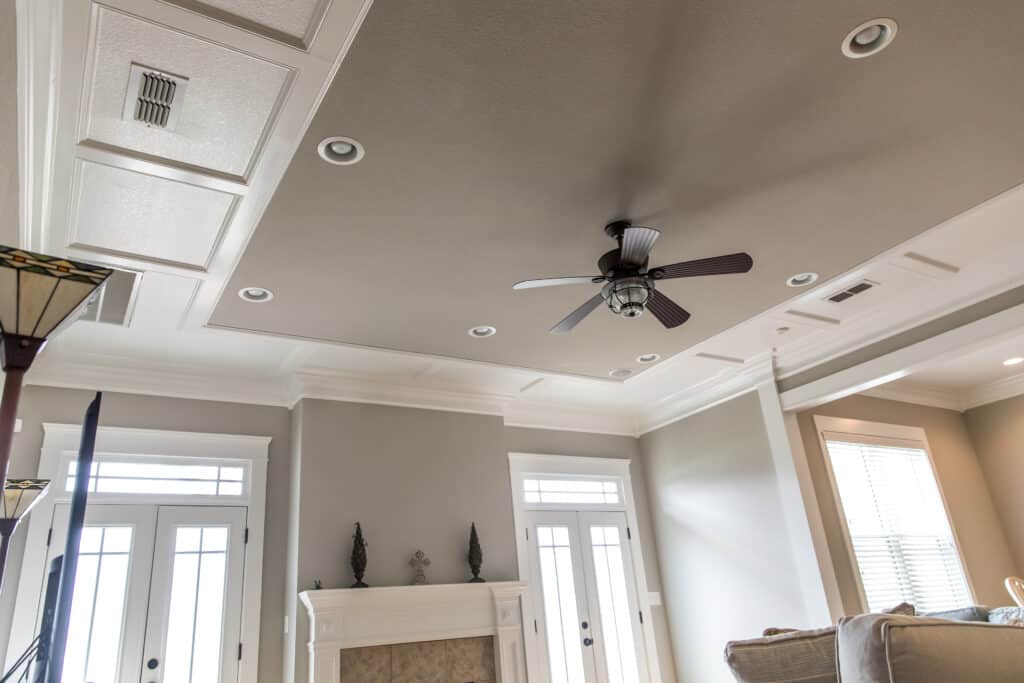
How Ceiling Fan Direction Affects Winter Heating
Ceiling fans are a staple in home comfort, often celebrated for their cooling power in the summer. However, they have an equally important role during winter. With the right settings, a ceiling fan can enhance heating efficiency, making your home warmer and cozier without overburdening your heating system.
Warm air naturally rises, leaving lower spaces feeling cooler even when the heat is on. By adjusting your ceiling fan to rotate clockwise at a low speed, you can redistribute this trapped heat throughout your living space. This simple change not only improves comfort but also helps you save energy and reduce heating costs.

Understanding Ceiling Fan Mechanics
Ceiling fans are more than simple home fixtures—they are a vital part of maintaining year-round comfort and energy efficiency. Unlike heating or cooling systems, ceiling fans do not change the room’s temperature. Instead, they circulate air to create a more balanced and comfortable environment, with their effectiveness largely depending on the direction of blade rotation.
During summer, ceiling fans rotate counterclockwise, creating a downdraft that pushes air down and produces a cooling breeze. This airflow mimics a wind-chill effect, making you feel cooler without adjusting the thermostat. However, the mechanics change drastically in winter, where proper fan direction becomes essential to your heating strategy.
When the blades rotate clockwise at a low speed, ceiling fans create an updraft. This motion draws cooler air upward while redistributing warm air trapped near the ceiling back into the living space. The result is a consistently warm room that reduces the workload on your heating system.
Mastering this simple adjustment not only enhances comfort but also cuts energy costs. A ceiling fan, when used correctly, is not just a convenience, it is a powerful tool that transforms how you heat and cool your home, making it a smarter, more efficient space year-round.
The Role of Airflow in Heat Distribution
Airflow plays an often-overlooked role in creating a warm and comfortable home during winter. Without understanding how air naturally moves, you could be wasting energy and enduring uneven temperatures. Warm air, being lighter, naturally rises to the ceiling, while cooler air remains near the floor. This process, known as thermal stratification, leaves you chilly where you need warmth the most, even if your heating system is running at full capacity.
When warm air stays trapped overhead, it creates a frustrating imbalance. Your heating system ends up working overtime to counteract this effect, increasing energy bills while failing to deliver consistent comfort. The result? You pay more for heat that does not reach the spaces where you spend most of your time.
This is where a ceiling fan can make a difference. By gently circulating air, ceiling fans disrupt stratification, pushing warm air back down into the room and lifting cooler air upward. This redistribution evens out temperatures across your space, reducing the strain on your heating system and making every corner of your home feel cozier.
Recognizing the importance of airflow and taking steps to improve it transforms your winter heating strategy, saving energy and enhancing comfort effortlessly.
Optimal Ceiling Fan Direction for Winter
When winter sets in, keeping your home warm efficiently becomes a priority. Most homeowners rely solely on their heating system, unaware of the potential of their ceiling fan. With a simple adjustment, your ceiling fan can play a crucial role in distributing heat evenly, saving energy, and reducing heating costs.
Adjust Your Fan to Rotate Clockwise
During winter, set your fan blades to rotate clockwise at a low speed. This creates a gentle updraft, pulling cooler air from the floor upward while pushing warm air trapped near the ceiling down along the walls and back into the room.
Improve Heat Distribution
Clockwise rotation eliminates cold spots and ensures that warm air circulates to all corners of your living space. The result is a more comfortable, evenly heated home without needing to increase the thermostat setting.
Enhance Energy Efficiency
By using your ceiling fan to distribute heat, your heating system does not need to work as hard. This reduces energy consumption and leads to noticeable savings on utility bills, making this adjustment both eco-friendly and cost-effective.
Quick and Easy to Implement
Changing the fan direction is simple. Most fans have a small switch located on the motor housing or a control option via remote. This minor effort translates into major comfort improvements throughout the colder months.
With your ceiling fan optimized for winter, you gain more than just comfort. You save energy, reduce heating costs, and extend the life of your heating system. It is a small, actionable step that yields significant benefits, turning your ceiling fan into a year-round essential.
Benefits of Correct Fan Usage in Winter
When it comes to winter comfort, most homeowners focus solely on their heating systems. However, your ceiling fan is an untapped resource that can significantly improve warmth and save money. By learning to use it correctly, you can achieve consistent comfort while easing the strain on your heating system.
Create a Comfortable Living Environment
Warm air naturally rises, leaving cooler air near the floor, and creating uneven temperatures in your living space. By setting your ceiling fan to rotate clockwise at a low speed, it pulls cooler air upward while gently redistributing the warm air from the ceiling back into the room. This ensures balanced heat distribution, eliminating cold pockets and making every part of your home feel consistently warm.
Reduce Energy Bills with Smart Heat Circulation
When warm air circulates effectively, your heating system does not need to run as frequently or at higher settings to maintain a comfortable temperature. This allows you to lower your thermostat without sacrificing warmth, which translates to significant energy savings over time.
Boost Energy Efficiency
Ceiling fans use only a fraction of the energy that heating systems consume. By leveraging their ability to circulate warm air, you not only save money but also make your home more energy-efficient. This small change reduces energy waste and lowers your household’s environmental impact.
Extend the Lifespan of Your Heating System
Consistent air circulation reduces the load on your furnace or heat pump, minimizing wear and tear. Over time, this means fewer repairs and a longer-lasting heating system, saving you money in the long run.
By making your ceiling fan part of your winter heating strategy, you can enjoy a warmer home, lower heating bills, and a more efficient living space. This small adjustment is a powerful way to enhance both comfort and savings throughout the colder months.

How to Adjust Your Ceiling Fan’s Direction
Switching your ceiling fan’s rotation is a small yet impactful step toward making your home more comfortable and energy-efficient during winter. Properly adjusted, your fan helps circulate warm air throughout the room, enhancing comfort and reducing heating costs. Follow these simple instructions to make the most of your ceiling fan in the colder months.
Step-by-Step Guide to Change Fan Rotation
- Turn Off the Fan Completely
For safety, start by switching off the ceiling fan and allowing the blades to come to a full stop. - Locate the Direction Switch
Most fans have a small switch on the motor housing. This switch typically toggles between “Forward” and “Reverse” settings, or has arrows indicating rotation directions. - Set to Clockwise (Reverse) Mode
Flip the switch to reverse the blade rotation to clockwise. This setting creates an updraft, gently pulling cool air upward and redistributing warm air throughout the room. - Turn the Fan Back On
Restart the fan and set it to a low speed. Low-speed operation ensures effective heat circulation without creating a draft.
Tips for Optimal Fan Performance
- Verify the Rotation Direction
Look at the blades from below. In winter, they should appear to move clockwise. If not, adjust the switch again. - Keep Speeds Low
Running the fan at low speed ensures warm air circulates gently, avoiding a cooling effect. - Inspect and Clean Blades
Dusty blades reduce efficiency and may spread allergens. Regular cleaning ensures smooth operation and maximum performance.
With these simple adjustments, your ceiling fan transforms into a key tool for maintaining warmth and efficiency. It is a quick fix that pays off in comfort and savings all winter long.
Maximizing Comfort in Multi-Level Homes
Heating a multi-level home or a room with high ceilings during winter can feel like a constant challenge. Warm air rises, leaving living spaces cold while trapping heat where it is not needed—at the ceiling or on the upper floors. This imbalance wastes energy and makes maintaining comfort nearly impossible. Fortunately, ceiling fans provide an easy, effective solution to even out temperatures and enhance your home’s comfort.
In high-ceiling rooms, heat gathers at the top, far from where you feel it most. By setting your ceiling fan to rotate clockwise at a low speed, it creates an updraft that moves cooler air upward while redistributing warm air throughout the space. This process keeps the heat circulating evenly, ensuring you feel warmer without overworking your heating system.
For multi-level homes, ceiling fans can prevent upper floors from becoming uncomfortably warm while helping lower levels retain heat. Installing fans in stairwells or open spaces between floors enhances airflow, ensuring heat reaches every corner of your home. In high-ceiling rooms, large-diameter fans maximize efficiency, while smaller rooms benefit from compact fans that provide targeted heat circulation.
Using ceiling fans strategically eliminates cold spots, balances heat, and reduces the strain on your heating system, all while cutting energy costs. With a simple adjustment, your ceiling fan becomes an invaluable tool for making winter living more comfortable and affordable.
Additional Tips for Maximizing Heating Efficiency
Maintaining warmth during the winter does not mean your energy bills have to skyrocket. With a few strategic adjustments, you can optimize your heating system, enhance comfort, and save money. Ceiling fans are a crucial yet often underused tool in this process. Here are actionable tips to get the most out of your heating strategy.
-
Reverse your ceiling fan direction
Set the fan to rotate clockwise at a low speed. This creates an updraft, pulling cool air upward and pushing warm air near the ceiling back into the living space. This simple adjustment ensures heat is evenly distributed, reducing the need to crank up the thermostat.
-
Seal and insulate your home
Drafts around doors, windows, and vents let valuable warm air escape. Sealing these leaks and ensuring proper insulation keeps the heat inside, allowing your ceiling fan and heating system to work together more effectively.
-
Use a programmable thermostat
Automating your heating system to lower temperatures when you are asleep or away prevents unnecessary energy waste. While the thermostat adjusts, ceiling fans can continue circulating residual warmth, maintaining comfort without added costs.
-
Take advantage of natural heat sources
Keep curtains and blinds open during the day to let sunlight naturally warm your home. Ceiling fans can distribute this solar heat, creating a consistent temperature throughout the room.
-
Maintain ideal indoor humidity levels
Dry air feels colder, making you turn up the heat unnecessarily. A humidifier can help maintain humidity levels around 40–60%, making the air feel warmer and more comfortable.
-
Combine ceiling fans with zoned heating systems
In multi-level homes, using ceiling fans in stairwells or common areas improves airflow between floors, reducing temperature discrepancies and keeping heating even throughout.
By integrating these tips, you can turn your ceiling fan into a powerful ally in your heating strategy. It is a small, cost-effective adjustment that leads to big savings, enhanced comfort, and a more energy-efficient home.
Why Richland Hills Residents Should Consider This
For residents of Richland Hills, staying comfortable during the winter months can be a challenge, especially when energy costs are on the rise. Many homeowners overlook the role ceiling fans can play in improving heating efficiency and creating a cozier living environment. Understanding how to use your ceiling fan effectively in winter can make a noticeable difference in both comfort and savings.
Richland Hills experiences fluctuating winter temperatures, which can strain heating systems and result in uneven warmth across your home. Ceiling fans offer a practical solution to these challenges. By setting your fan to rotate clockwise at a low speed, you can redistribute warm air trapped near the ceiling back into the living spaces. This adjustment ensures consistent temperatures throughout your home, even in rooms with high ceilings or areas prone to cold spots.
Energy efficiency is another key consideration. With heating costs accounting for a significant portion of household energy bills, using a ceiling fan to enhance heat circulation reduces the workload on your furnace. This not only cuts costs but also prolongs the lifespan of your heating system, which is especially important in Richland Hills, where reliable heating is essential during colder months.
Additionally, combining ceiling fan usage with other smart heating strategies, like sealing drafts and using programmable thermostats, can help Richland Hills residents make the most of their heating systems. By leveraging these tools, you can maintain a comfortable home environment while minimizing energy waste and contributing to a more sustainable lifestyle.
For homeowners in Richland Hills, using a ceiling fan strategically in winter is not just about comfort, it is about smarter energy use and long-term savings. Small adjustments can lead to big results, keeping your home warm and efficient all season long.
FAQs
-
What direction should a ceiling fan rotate in winter?
In winter, set your ceiling fan to rotate clockwise at a low speed. This creates an updraft, pulling cooler air upward and redistributing warm air that has risen to the ceiling. This adjustment ensures that heat spreads evenly throughout the room, helping you stay comfortable without increasing your thermostat setting.
-
How can I check if my ceiling fan is in the correct mode for winter?
To confirm, stand beneath the fan while it is running at low speed. The blades should appear to move clockwise, and you should not feel a breeze directly beneath the fan. Instead, you will notice a gentle redistribution of air as warm air circulates downward along the walls.
-
Does using a ceiling fan in winter increase energy consumption?
No, ceiling fans use minimal energy, especially on low settings. Using a ceiling fan in winter can lower energy costs. By efficiently redistributing warm air, the fan reduces the workload on your heating system, allowing you to lower your thermostat setting without sacrificing comfort.
-
Are ceiling fans effective in rooms with high ceilings or multi-level homes?
Yes, ceiling fans are particularly useful in these spaces. Warm air rises to the highest points in high-ceiling rooms and upper levels in multi-story homes. A clockwise-spinning fan circulates this trapped heat back into living areas, creating consistent warmth throughout the space.
-
How often should I adjust my ceiling fan’s direction?
You should adjust your fan’s direction seasonally. Use clockwise rotation in winter to enhance warmth and counterclockwise rotation in summer to create a cooling breeze. These adjustments ensure your ceiling fan works efficiently year-round, complementing both heating and cooling systems.
Proper ceiling fan use can transform your home’s comfort and efficiency this winter. For expert advice or heating assistance, contact One Hour Air Conditioning & Heating of Fort Worth today. Let us help you stay warm while saving energy!


